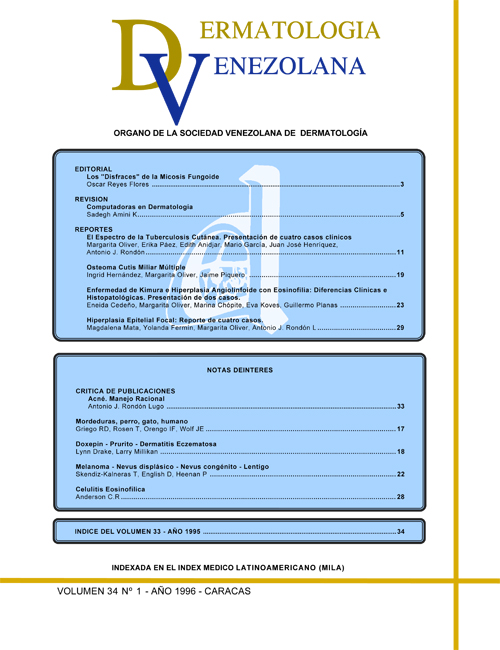ENFERMEDAD DE KIMURA E HIPERPLASIA ANGIOLINFOIDE CON EOSINOFILIA: DIFERENCIAS CLINICAS E HISTOPATOLOGICAS PRESENTACION DE DOS CASOS
Palabras clave:
ENFERMEDAD DE KIMURA, HIPERPLASIA ANGIOLINFOIDEResumen
Existe considerable controversia acerca de la relación entre la enfermedad de Kimura y la Hiperplasia angiolinfoide eosinofílica (HALE). Los autores presentan y revisan los hallazgos clínicos e histopatológicos de dos casos con estos diagnósticos. La enfermedad de Kimura se presenta en una paciente (adulto joven) de 44 años como un nódulo subcutáneo profundo, la piel que lo recubre es normal, de curso crónico y recidivante posterior a su intervención quirúrgica, sin tendencia al sangrado. El estudio histológico muestra folículos linfoides típicos con proliferación vascular periférica y eosinofilia periférica. La HALE se observó en un paciente de 72 años con nódulo exofítico en cuero cabelludo, la piel que lo recubre es eritematosa, de meses de evolución y fácil tendencia a ulcerarse y sangrar. El estudio histológico permitió observar acentuada proliferación vascular cuyas células endoteliales de tipo epitelioide se proyectan hacia la luz con un citoplasma vacuolado rodeados por un estroma con acentuada fibrosis. Se realiza la revisión de la literatura y se concluye que son entidades separadas diferenciables tanto desde el punto de
vista clínico como histológico.
ABSTRACT
There has been considerable controversy about the relation between Kimura's disease and Angiolymphoid Hiperplasia with Eosinophilia (ALHE). The authors review clinical findings and histopathologic changes in one case of Kimura's disease and one case of ALHE. Kimura's diseases is described in a 40- years-old female with a deep nodule appeared in the superior lip for one year, the skin over was normal. A similar lesion had appeared at the same site one year before and had been excised. The histologic findings were: the subcutaneous fat contained many lymphoid follicies with abundant eosinophils, marked proliferation and dilatation of vessels. The AHLE was observed in a 72-year-old man with exophitic erythematous nodule in scalp, from two years, that was growing slowly tendency to eroded and bleeding, the histological study demostrade in mid dermis, capillaries and small vessels were increased and dilated, the endothelial cells protruded into the lumen producing a cobblestone appearance some endothelial cells and vacuoles in their cytoplasms, the stroma was fibrotic with a moderate infiltrate of mononuclears cells.
The authors review the literature with the conclution that Kimura's disease and ALHE are separate entities.
Descargas
Número
Sección
Licencia
Publicado por la Sociedad Venezolana de Dermatología Médica, Quirúrgica y Estética







